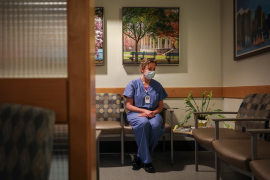By Jane Norman, CQ HealthBeat Associate Editor
September 10, 2009 -- The percentage of children lacking health insurance declined in 2008 due to increasing enrollment in public programs and hit its lowest rate since comparable data first was collected in 1987, the U.S. Census Bureau reported in estimates released Thursday.
Health experts said the new estimates show the importance of both Medicaid and the Children's Health Insurance Program (CHIP), which recently was reauthorized by Congress and expanded. Both the Department of Health and Human Services and state agencies have pushed to enroll additional eligible children in CHIP.
However, the relatively good news about children was offset by the estimates for adults. The number of Americans of all ages without insurance rose from 45.7 million in 2007 to 46.2 million in 2008, the census said. While the percentage of uninsured remained statistically the same in 2007 and 2008, at about 15.4 percent, President Obama and advocacy groups said the new statistics demonstrate again the need for change in the health care system.
About 20 percent of adults age 18 to 64 were without insurance in 2008, and the number who received group insurance provided by their employers plunged by about 1 million, continuing a long-term trend over the past decade. While 62 percent of Americans had employment-based coverage in 1987, 58.5 percent reported such coverage in 2008.
Enrollment in both Medicaid and Medicare went up, too. The percentage and number of people enrolled in Medicaid increased to 14.1 percent and 42.6 million in 2008, the census said. As baby boomers entered their mid-60s, enrollment in Medicare increased to 14.3 percent and 43 million in 2008.
David Johnson, chief of the housing and household economic statistics division of the census, told reporters in a conference call that the estimates in the Current Population Survey were collected in March of this year. Those surveyed were considered to have insurance if they were enrolled in a plan at any time during 2008, even for a short period, which census officials say means that the numbers of uninsured Americans likely are understated. For example, some workers may have had insurance early in 2008 and then lost their jobs.
The situation likely is worse now, experts said. The August 2009 U.S. unemployment rate of 9.7 percent is more than two percentage points higher than it was in 2008, when it hit a high of 7.2 percent in December.
Obama, fresh from his health care speech Wednesday night before a joint session of Congress, said that "more up-to-date surveys" have found that since the recession intensified in September, more people have lost their health insurance. Even those who do have insurance "have never had less security and stability than they do right now," Obama said at an event with the American Nurses Association.
"Because they're subject to the whims of health insurance companies, many people fear that they'll lose their health insurance if they move or if they lose their job, they change jobs, or that insurance just won't cover them when they need it most," said Obama, making the case that it's time for Congress to act on the overhaul.
Robert Greenstein, director of the liberal-leaning Center on Budget and Policy Priorities, called the census report "grim" for its findings on health insurance as well as poverty and income. As Americans reeled from the recession, real median household income fell by 3.6 percent to $50,303 in 2008 and the official poverty rate rose to 13.2 percent compared with 12.5 percent in 2007, the census said.
"What's of particular concern is that virtually every figure will look considerably worse a year from now," said Greenstein. He said center researchers expect the number of people living in poverty will hit a 50-year high in 2009, and the number of uninsured will climb toward 50 million.
The census said that 9.9 percent of children under 18 lacked health insurance in 2008, compared with 11 percent in 2007. The number of uninsured children fell from 8.1 million in 2007 to 7.3 million in 2008, the lowest number since 1987.
Among uninsured children, 29.1 percent lived in households with incomes of $29,000 or less, 32.7 percent in households with incomes of $25,000 to $49,999, 18.1 percent in households with incomes of $50,000 to $74,999 and 20.1 percent in households with incomes of $75,000 or more.
Children living in poverty still tend to be more likely to be uninsured, as well as teens. Hispanic children had the highest rate of uninsurance at 17.2 percent, while the rate for non-Hispanic white children was 6.7 percent, for black children 10.7 percent and for Asian children 10.9 percent.
Among regions, the Northeast and Midwest had the lowest rates of uninsured citizens, while the South had the highest. Massachusetts, which requires that most people have health insurance, had the lowest rate at 5.5 percent and Texas the highest at 25.1 percent.
Karen Davis, president of the Commonwealth Fund, a policy research foundation, said all of the estimates would have been far worse but for the growing enrollment in public programs, such as an increase of 3 million people enrolled in Medicaid. She also pointed out that problems with insurance now are creeping up the income tiers. The census estimated that about 20 percent of the uninsured live in households earning $75,000 a year or more. "An uninsured population of 46.3 million Americans is staggering," Davis said.
Scott Serota, president and CEO of the Blue Cross and Blue Shield Association, said it is "unacceptable" that so many Americans lack insurance. He said the insurer wants to work towards a bipartisan solution and supports an overhaul that builds on the employer-based system and changes in the market, rather than "a new government-run health plan that would cause millions of Americans to lose the private coverage they enjoy."


